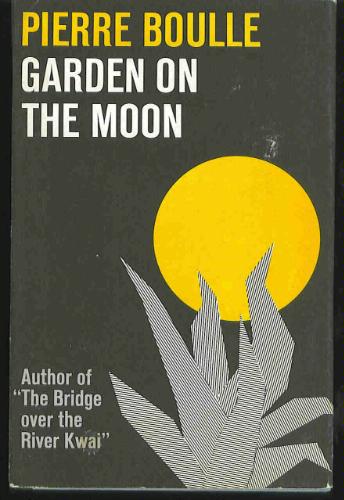This is part of a series on French author Pierre Boulle.

Julliard, 1964
translated by Xan Fielding
Vanguard Press, 1965
315 pages
Boulle’s third book to be translated into English demonstrates the writer’s gift for creating heightened tension in the plot and then easing it with a heavy dose of irony. And if you like learning about the space race of the 1950s and 60s, you’ll love this book.
Garden on the Moon is a unique tale in that it begins as fictionalized history and then turns into, what was for Boulle, speculative fiction but what is, for us now in 2022, alternative history. I know–it’s a bit confusing. In his introduction, Boulle explains that the last thing he wants to do is write about the near future and then have that future turn out so differently in his lifetime that his book is dismissed or ridiculed. While writing the book, which includes several real-life figures such as JFK, Hitler, and Stalin, Boulle heard that the former had been assassinated, thus prompting him to revise parts of the story. Nonetheless, the race to the moon was real in the early Cold War era and it was anyone’s guess who would get there first (the Americans? the Russians? another country?). So what that Boulle’s guess didn’t turn out to be the right one? I actually think he was counting on it.
The moon landing in 1969 was not that long ago, though to those of us born at least a decade after that event, it seems like forever. The video is grainy, the technology seems dated, and we’ve now had several decades of Star Trek, Star Wars, and numerous other visually-engaging science fiction shows and movies. I remember watching the video of Neil Armstrong setting foot on the moon, after I had already been watching Star Trek: TNG for years, and trying to imagine what it must have felt like for my mom, dad, grandparents, and the millions of others who watched it on television that day in 1969. For Pierre Boulle, writing Garden on the Moon in 1963-64, humans still hadn’t reached that natural satellite, and no one could be sure that we ever would. And yet, Boulle offers us an idea of what might have happened, had Japan entered the space race alongside the US and USSR.
Though Boulle changed the names of characters, it’s clear that the main character Dr. Stern is none other than Dr. Wernher von Braun, who helped develop Germany’s, and then the United States’, rocket technology. Like von Braun, Stern directs research and development under the Nazi regime at a test site called Peenemünde, where he ostensibly works on rockets that can hit England and the United States, while his real goal is to develop rockets that can land humans on the moon and Mars and return them to Earth.
When the Americans and Soviets converge on Berlin, Stern (like von Braun) surrenders to the Americans, believing that their funding and commitment to the space race with Russia will mean opportunities to finally realize his ultimate goal of landing on the moon. Once more, Stern finds himself stymied by bureaucracy and parsimony. His fellow scientists from Peenemünde and elsewhere go to Japan, Russia, France, and Egypt, though they meet up frequently at aerospace conferences and exchange ideas (which I bet their governments wouldn’t have liked!). And when the Soviets launch the first man-made satellite into orbit, Stern goes…a bit ballistic.
While the book mostly follows Stern in his increasingly obsessive efforts to beat the Soviets to the moon, parts of it are longer than necessary (Boulle’s editor could have been a bit more heavy-handed, is all I’m saying, former editor that I am). Sometimes Boulle drops us in the minds of Russian scientists, sometimes in that of the Japanese aerospace engineer Dr. Kanashima. In the vein of all good unexpected endings, it is the scientist we are least likely to expect who stuns the world and reaches the moon first–all because he came up with a radical solution to the decades-old problem of how to return the astronauts from the moon to Earth.
As in his other stories and novels, Boulle takes care to remind us that the structures that serve as the visuals of scientific achievement (rockets, engines, capsules, etc.) bear a striking resemblance to the magnificent cathedrals and temples of previous centuries; scientific drive, Boulle suggests, isn’t a whole lot different than religious fervor:
[Stern] forced himself to close his eyes and recovered a little composure, shaking off the romantic images that the Peenemünde staff was only too inclined to evoke in connection with rockets: obelisk, church steeple, cathedral spire. (16)
The satellite in its dazzling gold plate had been carried onto the pad by the admiral himself. Opening its case, he raised the fragile instrument into the air at arm’s length, like a priest consecrating the Host. (137-38).
The final scenes (on the moon!) have a deliberately poetic quality and reveal Boulle’s deep interest in getting the facts right (as they were known at the time) and blending them with plausible and dream-like imagery that lines up with humanity’s centuries-long romanticization of that beloved natural satellite of ours. So while Garden on the Moon tries to do a lot of things, its underlying curiosity about the future of humanity and optimism (mixed with irony) about the future is understandably engaging.

1 comment on “Review: Garden on the Moon by Pierre Boulle”